The new iPad: Retina Display Analysis
by Anand Lal Shimpi on March 19, 2012 5:49 PM ESTQuantifying Display Performance: Big Gamut Gains
Pixel density may have improved, but what about the rest of the display characteristics? We'll start with the usual suspects - brightness, black levels and contrast ratio:
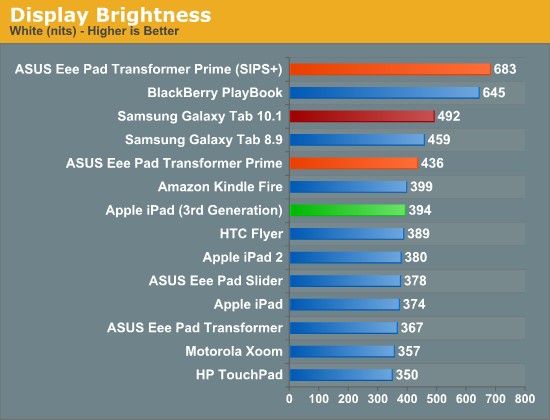
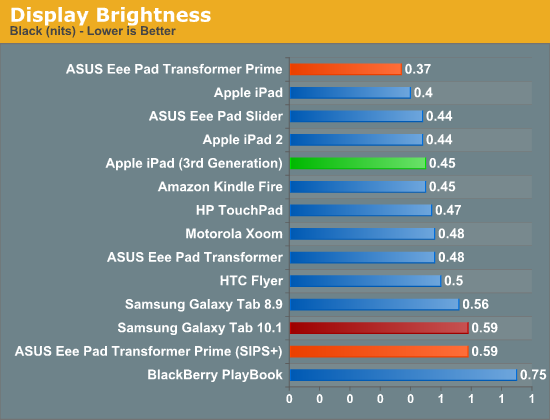
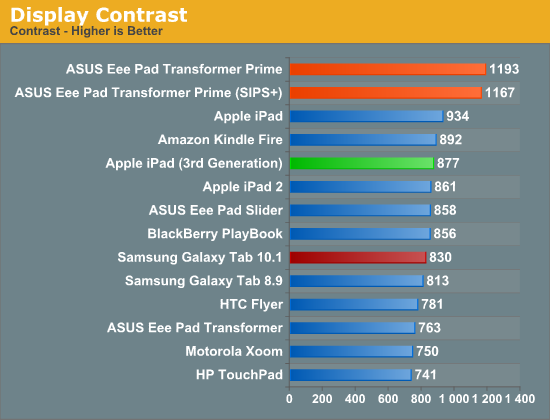
Despite a tremendous increase in pixel count and density, the new iPad delivers roughly the same brightness and contrast ratio as its predecessor. White point remains unchanged as well at ~6700K.
At the introduction of the new iPad, Apple briefly mentioned a 44% increase in color saturation from the new panel. Although the old display definitely looked good, the new one does actually look better. My eyes aren't normally the best judge of gamut, but we have some tools to help quantify exactly what I was seeing:
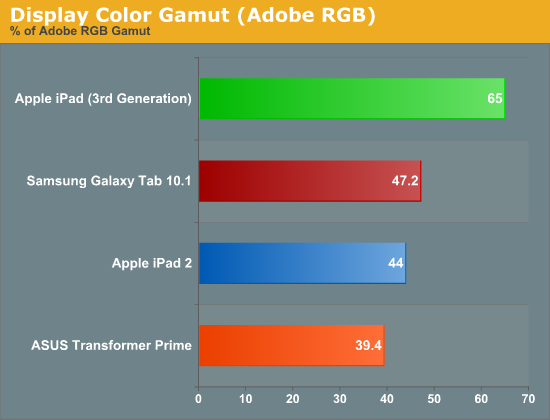
Color gamut has definitely improved. While the iPad 2 and TF Prime both were able to represent ~40% of the Adobe RGB color gamut, the new iPad jumps by nearly 50% to representing 65% of the Adobe RGB gamut. More impressive are the gains you see if you look at the color gamut of the new panel compared to the sRGB space:
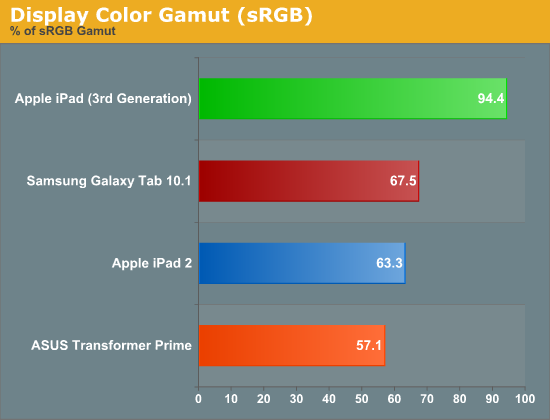
Here the panel is able to deliver nearly full coverage of the sRGB color gamut. Below is the CIE diagram for the new panel with an sRGB reference plotted on the same chart so you can visualize the data another way (the white triangle is the new iPad, the gray outer triangle is the sRGB reference):
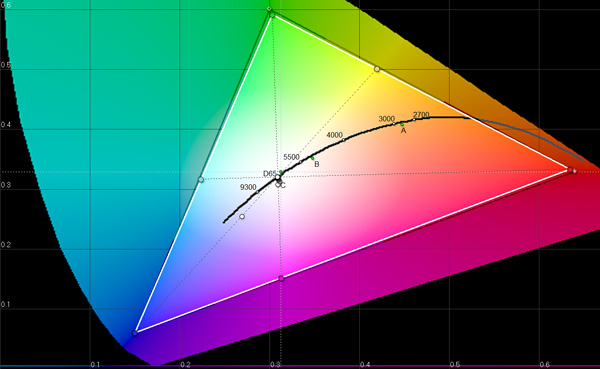
Near perfect coverage. The new iPad's display is a huge step forward in both pixel density and being able to represent a wider color gamut. While it's still no where near the quality of high-end PC displays, this is real progress for tablets. The bar has been raised.
















172 Comments
View All Comments
dagamer34 - Tuesday, March 20, 2012 - link
Operating systems and apps haven't supported high DPI displays on smaller screens. For the longest time, OS vendors believed that vector graphics were the solution, but pixel doubling is a good enough solution that it's clearly the path forward now.gorash - Tuesday, March 20, 2012 - link
Maybe battery is the issue.tipoo - Tuesday, March 20, 2012 - link
I'm guessing Apple will keep moving Retina-ish displays up the line. First 3.5" displays, then 9.7", probably 11" and 13" Airs at the same time next, then the Macbook Pros.aranyagag - Monday, March 19, 2012 - link
I am a person who never even considers apple products-- I am as much of an anti apple fanboy as it is possible to be.Unfortunately, their products -- Display wise have EXACTLY what I want. Why the hell do the windows / android camp not GET IT. I mean Macbooks pros have had 16:10 MATT screens and now the ipad has 4:3 wide gamut(for tablets) display
kmmatney - Monday, March 19, 2012 - link
I'm just waiting for a someone to step up and make a 16:10 windows laptop. If someone wants to stand -out from the crowd, now is their chance.Solandri - Monday, March 19, 2012 - link
Display-wise, Apple has always been at the forefront since their products have traditionally sold to graphics artists and photographers. Mac OS supported 24-bit colors back when the best Windows hardware supported 16-bit (15-bit really). Resolutions could go higher. Apps were color space-aware. Color calibration and a LUT were supported. Monitors were color-calibrated out of the factory for sRGB, so you got semi-accurate colors even if you didn't have calibration equipment. etc. Their only faux pas IMHO was switching the Macbooks to glossy TN panels.gorash - Tuesday, March 20, 2012 - link
OLED > LCD. Galaxy Tab 7.7 has an OLED screen.doobydoo - Tuesday, March 20, 2012 - link
The Galaxy Tab also has awful difficulty running the previous of version of Android, since it doesn't even have ICS yet.It's also more expensive than even the new iPad, in the UK.
The Galaxy 7.7 is £429
The new iPad starts at £399, the old one £329.
You would have to be mental to pay more for a slower, laggy, lower resolution tablet which doesn't even have the latest operating system out.
Btw, the screen on the new iPad is LCD, but not just LCD. It has IPS technology which addresses all of the issues of LCD, meaning that to normal users it's every bit as good.
ssddaydream - Tuesday, March 20, 2012 - link
You are probably correct for that for most people, IPS LCD is perfectly good.For me, I literally can't stand any LCD I've seen.
The iPhone 4 screen annoys me.
I still have a Sony Artisan CRT and I use a SAMOLED+ phone.
I won't even bother with a tablet until there is a high-res SAMOLED+ display with Windows 8. Android would probably be acceptable, but I'd prefer Windows 8.
myhipsi - Tuesday, March 20, 2012 - link
You're just a contrarian. How does the iPhone 4 screen "annoy" you? It's, by far, one of the best phone displays on the market. As for LCD monitors? A Dell u3011 absolutely smokes that Sony CRT in every area other than black level and refresh rate.